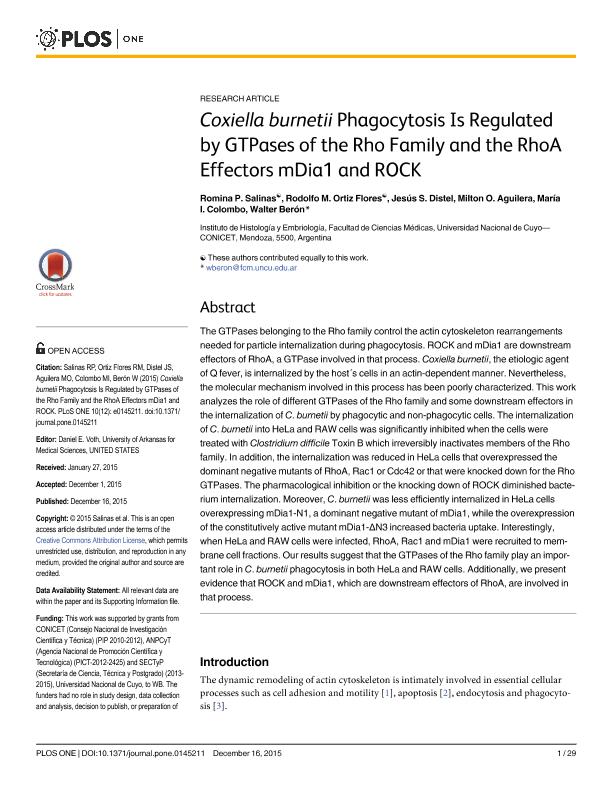Mostrar el registro sencillo del ítem
dc.contributor.author
Salinas Ojeda, Romina Paola

dc.contributor.author
Ortiz Flores, Rodolfo Matias

dc.contributor.author
Distel, Jesús Sebastián

dc.contributor.author
Aguilera, Milton Osmar

dc.contributor.author
Colombo, Maria Isabel

dc.contributor.author
Beron, Walter

dc.date.available
2018-04-09T14:24:08Z
dc.date.issued
2015-12
dc.identifier.citation
Salinas Ojeda, Romina Paola; Ortiz Flores, Rodolfo Matias; Distel, Jesús Sebastián; Aguilera, Milton Osmar; Colombo, Maria Isabel; et al.; Coxiella burnetii Phagocytosis Is Regulated by GTPases of the Rho Family and the RhoA Effectors mDia1 and ROCK; Public Library of Science; Plos One; 10; 12-2015; 1-29
dc.identifier.issn
1932-6203
dc.identifier.uri
http://hdl.handle.net/11336/41299
dc.description.abstract
The GTPases belonging to the Rho family control the actin cytoskeleton rearrangements needed for particle internalization during phagocytosis. ROCK and mDia1 are downstream effectors of RhoA, a GTPase involved in that process. Coxiella burnetii, the etiologic agent of Q fever, is internalized by the host´s cells in an actin-dependent manner. Nevertheless, the molecular mechanism involved in this process has been poorly characterized. This work analyzes the role of different GTPases of the Rho family and some downstream effectors in the internalization of C. burnetii by phagocytic and non-phagocytic cells. The internalization of C. burnetii into HeLa and RAW cells was significantly inhibited when the cells were treated with Clostridium difficile Toxin B which irreversibly inactivates members of the Rho family. In addition, the internalization was reduced in HeLa cells that overexpressed the dominant negative mutants of RhoA, Rac1 or Cdc42 or that were knocked down for the Rho GTPases. The pharmacological inhibition or the knocking down of ROCK diminished bacterium internalization. Moreover, C. burnetii was less efficiently internalized in HeLa cells overexpressing mDia1-N1, a dominant negative mutant of mDia1, while the overexpression of the constitutively active mutant mDia1-ΔN3 increased bacteria uptake. Interestingly, when HeLa and RAW cells were infected, RhoA, Rac1 and mDia1 were recruited to membrane cell fractions. Our results suggest that the GTPases of the Rho family play an important role in C. burnetii phagocytosis in both HeLa and RAW cells. Additionally, we present evidence that ROCK and mDia1, which are downstream effectors of RhoA, are involved in that process
dc.format
application/pdf
dc.language.iso
eng
dc.publisher
Public Library of Science

dc.rights
info:eu-repo/semantics/openAccess
dc.rights.uri
https://creativecommons.org/licenses/by-nc-sa/2.5/ar/
dc.subject
Coxiella Burnetii
dc.subject
Phagocytosis
dc.subject
Rho Gtpases
dc.subject
Mdia
dc.subject
Rock
dc.subject.classification
Otras Ciencias Biológicas

dc.subject.classification
Ciencias Biológicas

dc.subject.classification
CIENCIAS NATURALES Y EXACTAS

dc.title
Coxiella burnetii Phagocytosis Is Regulated by GTPases of the Rho Family and the RhoA Effectors mDia1 and ROCK
dc.type
info:eu-repo/semantics/article
dc.type
info:ar-repo/semantics/artículo
dc.type
info:eu-repo/semantics/publishedVersion
dc.date.updated
2018-03-27T13:35:49Z
dc.journal.volume
10
dc.journal.pagination
1-29
dc.journal.pais
Estados Unidos

dc.journal.ciudad
San Francisco
dc.description.fil
Fil: Salinas Ojeda, Romina Paola. Consejo Nacional de Investigaciones Científicas y Técnicas. Centro Científico Tecnológico Conicet - Mendoza. Instituto de Histología y Embriología de Mendoza Dr. Mario H. Burgos. Universidad Nacional de Cuyo. Facultad de Cienicas Médicas. Instituto de Histología y Embriología de Mendoza Dr. Mario H. Burgos; Argentina
dc.description.fil
Fil: Ortiz Flores, Rodolfo Matias. Consejo Nacional de Investigaciones Científicas y Técnicas. Centro Científico Tecnológico Conicet - Mendoza. Instituto de Histología y Embriología de Mendoza Dr. Mario H. Burgos. Universidad Nacional de Cuyo. Facultad de Cienicas Médicas. Instituto de Histología y Embriología de Mendoza Dr. Mario H. Burgos; Argentina
dc.description.fil
Fil: Distel, Jesús Sebastián. Consejo Nacional de Investigaciones Científicas y Técnicas. Centro Científico Tecnológico Conicet - Mendoza. Instituto de Histología y Embriología de Mendoza Dr. Mario H. Burgos. Universidad Nacional de Cuyo. Facultad de Cienicas Médicas. Instituto de Histología y Embriología de Mendoza Dr. Mario H. Burgos; Argentina
dc.description.fil
Fil: Aguilera, Milton Osmar. Consejo Nacional de Investigaciones Científicas y Técnicas. Centro Científico Tecnológico Conicet - Mendoza. Instituto de Histología y Embriología de Mendoza Dr. Mario H. Burgos. Universidad Nacional de Cuyo. Facultad de Cienicas Médicas. Instituto de Histología y Embriología de Mendoza Dr. Mario H. Burgos; Argentina
dc.description.fil
Fil: Colombo, Maria Isabel. Consejo Nacional de Investigaciones Científicas y Técnicas. Centro Científico Tecnológico Conicet - Mendoza. Instituto de Histología y Embriología de Mendoza Dr. Mario H. Burgos. Universidad Nacional de Cuyo. Facultad de Cienicas Médicas. Instituto de Histología y Embriología de Mendoza Dr. Mario H. Burgos; Argentina
dc.description.fil
Fil: Beron, Walter. Consejo Nacional de Investigaciones Científicas y Técnicas. Centro Científico Tecnológico Conicet - Mendoza. Instituto de Histología y Embriología de Mendoza Dr. Mario H. Burgos. Universidad Nacional de Cuyo. Facultad de Cienicas Médicas. Instituto de Histología y Embriología de Mendoza Dr. Mario H. Burgos; Argentina
dc.journal.title
Plos One

dc.relation.alternativeid
info:eu-repo/semantics/altIdentifier/doi/http://dx.doi.org/10.1371/journal.pone.0145211
dc.relation.alternativeid
info:eu-repo/semantics/altIdentifier/url/http://journals.plos.org/plosone/article?id=10.1371/journal.pone.0145211
Archivos asociados
